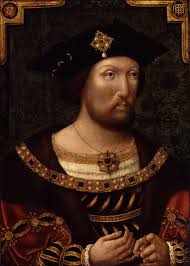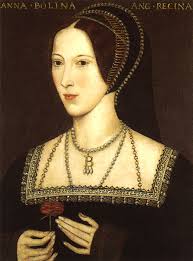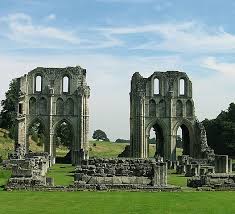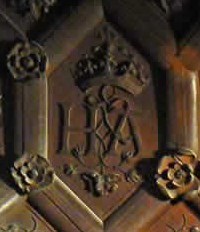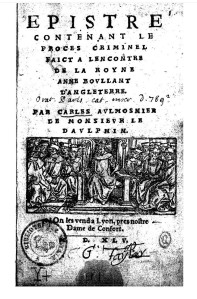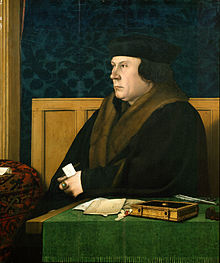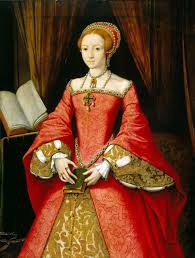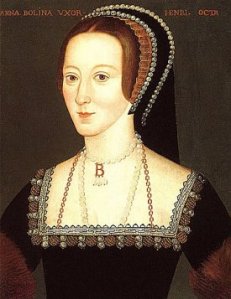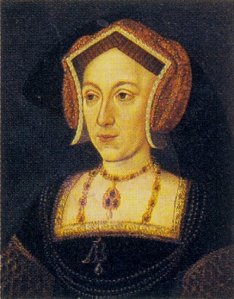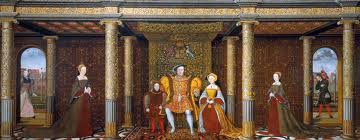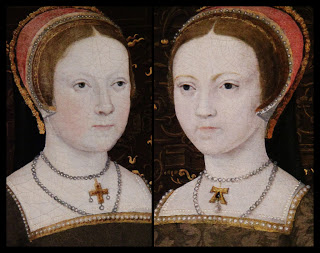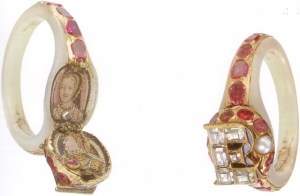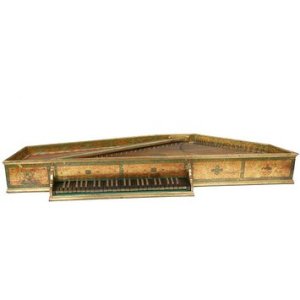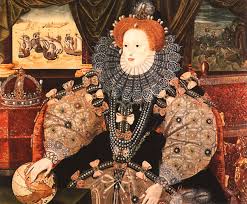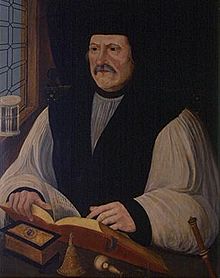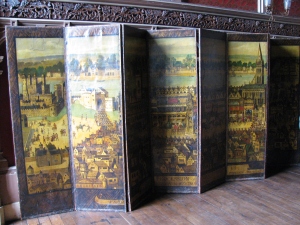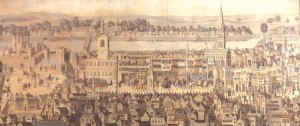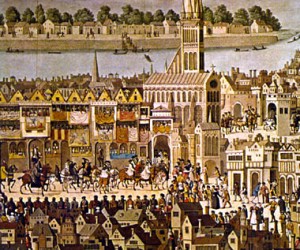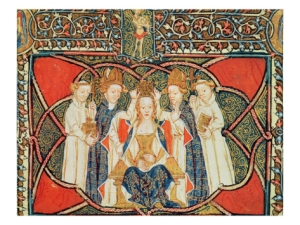Path to St. Peter ad Vincula Part VII – F
The fall of Anne Boleyn will never be fully understood or explained. Her descent appears to have happened so quickly as to baffle scholars and lay-people alike. Most likely it was the result of many factors that came to head all at once: the revenge of Cromwell for past slights, the political situation — both domestic and international — the religious circumstances and the disillusionment of King Henry.
Henry’s role in Anne’s demise, often described as that of an innocent victim–a righteous man who, when presented with the facts of his adulterous wife, follows the letter of the law and allows officialdom to prosecute her as appropriate. Rumors spread that there were spies in her household and that “the King hates the Queen, because she has not presented him with an heir to the realm, nor was there any prospect of her so doing” (Stevenson 1312). Henry, frustrated by a politically active, argumentative wife, saw Anne’s demise as the only way out. Divorce was not enough, nor was execution. Henry’s rage required both punishments inflicted on Anne along with the defamation of her character.
No rumor was considered too fanciful to believe. Stories circulated that the honor Anne had acquired to join the royal court in France stemmed from the fact that at “fifteen she sinned first with her father’s butler, and then with his chaplain, and forthwith was sent to France” (Sander 25). While in France, Anne was supposed to have been the lover of many couriers and “her conversation hath been so loose and base” (Harpsfield 253) and her behavior “so rank and common” (Friedmann 298) that understandably she was “audacious and licentious in the prosecution of her detestable and abominable vices” (Gairdner X 54).
There was no end to the implied and declared evils of Anne by the Spanish Ambassador, Eustace Chapuys. He claimed her to be a seductress and murderess, “whose importunate and malignant cravings are well known” (de Gayangos 1133). Convinced that Anne would try to poison Queen Katherine and Princess Mary, Chapuys reported that although the “Queen has no fears, but is marvelously concerned for the Princess” (Gairdner VI 351). Added to the speculation that Anne tried to murder members of the royal family, there was laid the charge of her role in the deaths of public figures. Bishop Fisher of Rochester and Sir Thomas More were “both inscribed on the black-list of the revengeful mistress, who never rested from her ill offices toward them, until their heads had fallen” (Herbert, Henry 171).
“Yet did not our King love her at first”(Herbert, Edward 285). Although Henry was touted as a hero of the Protestant cause and liberator of the English peoples, he also was blamed for how he “stained the purity of his action by intermingling with it a weak passion for a foolish and bad woman, and bitterly he had to suffer for his mistake” (Froude 324). “A long catalog of misdeeds had been registered…” It was puzzling to many that Henry did not realize Anne had “worn a mask so long” and never gave Henry “occasion for dissatisfaction. Incidents must have occurred in the details of daily life, if not to rouse his suspicions, yet to have let him see that the woman for whom he had fought so fierce a battle had never been worthy what she had cost him” (Froude 402).
These sentiments are very different from when Anne was at her heyday; yet, all was not as it seemed as observed by Jean du Bellay, Bishop of Bayonne, Ambassador from France on December 9, 1528. “I see they mean to accustom the people by degrees to endure her, so that when the great blow comes it may not be thought strange. However, the people remain quite hardened, and I think they would do more if they had more power; but great order is continually taken” (Brewer IV 5016).
Hence a severe ordinance was issued “against any that spoke ill of her; which shut people’s mouths when they knew what ought not to be concealed.” Anne could do as she pleased and “if perhaps taken with the love of some favored person, she could treat her friends according to her pleasure, owing to the ordinance. But that law could not secure to her lasting friendships, and the King daily cooled in his affection” (Gairdner X 1036). Therefore, with the King’s new policies and his actions, such as the execution of More, causing so much hostility toward Anne Boleyn, the Crown’s agents were kept busy trying to preserve public order and ensure the people would accept the new edicts. Records show several examples of the investigations into many reported violations. Although the punishments are not always documented, below are brief summaries of some of the charges against those of all stations of life.
In April of 1532 Charles Brandon’s kinsman, William Peninthum was assaulted and killed by the men in the service of the Duke of Norfolk. When Thomas Cromwell investigated it came to light that the root of the trouble came from “opprobrious language uttered against Madam Anne by his Majesty’s sister, the Duchess of Suffolk, Queen Dowager of France” (Brown IV 761).
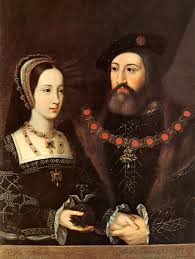
Charles Brandon, 1st Duke of Suffolk and Mary, Dowager Queen of France, Duchess of Suffolk.
Edward Earl of Derby and Sir Henry Farington wrote a letter to Henry VIII concerning the widespread discontent over his marriage to Anne Boleyn. The men informed Henry that they felt compelled to send a letter of the examinations they had made of various witnesses because of “the discharge of our duties” (Ellis 42). Sir Edward and Sir Farington “perceyve your graces pleasor is that a lewde and noghty priest inhabytyng in thise partyes, who hathe of late reported and spoken befor and in the audyence of certeyn persons sundry and diverse unfyttyng and sklaunderous words, aswell by your Highnes as by the Quenes grace” (Ellis 42). They assured Henry that they “have called befor us suche persons whose names and dsposicions hereafter do enue; and the same persons did examyn upon ther othes at Ley in the Countie of Lancaster” (Ellis 43).
In 1533 a Warwickshire priest called Anne “a harlot and maintainer of heretics” and expressed the hope that “she would be burned at Smithfield” (Haigh 141).
Evidently, in Lancashire, when Sir Richard Clerke, a vicar at Leigh, read out the proclamation declaring Katherine of Aragon as Princess Dowager, “Sir Jamys Harrison priest hering the said proclamacion, said that Quene Katharyn was Quene, And that Nan Bullen whuld not be Quene, nor the King to be no King but on his bering” (Ellis 43). Substantiated by many witnesses, a more strongly worded exclamation was related that “Sir Jamys said I will take non for Quene but Quene Katharin; who the devell made Nan Bullen that hoore Quene, for I will never take her for Quene, and the King on his bering” (Ellis 44).
A scuffle between an ostler of the White Horse in Cambridge with a customer, Henry Kilby, in May of 1534 did not go unnoticed by the authorities. During a discussion over the religious changes occurring in the country, the inn worker declared that “this business had never been if the king had not married Anne Boleyn” (Wilson). He was duly reported after blows were exchanged between the two men.
Sir Walter Stonor described, in a letter to Master Secretary Cromwell, the affidavit presented by John Dawson of Watlyngton in June of 1534. Dawson and a William Goode, the constable, documented a conversation which took place between Mrs. Burgyn of Watlington in Oxfordshire and her midwife, Joan Hammulden. It was alleged that while in labor Burgyn praised Hammulden by saying that “for her honesty and cunning … she might be midwife to the Queen of England, if it were Queen Catherine, and if it were Queen Anne she was too good to be her midwife, for she was a whore and a harlot for her living” (Elton 279). Mrs. Burgyn counter claimed that Joan replied that “it was never merry in England since there was three queens in it and …there would be fewer shortly” (Gairdner VII 840).
On 20 August 1535, the high constable of South Brent, John Gillinge, and John Buckett informed Thomas Clerk and William Vowell that “David Leonard, hooper, an Irishman, had said, ‘God save king Henry and queen Katharine his wedded wife, and Anne at his pleasure, for whom all England shall rue” (Gairdner IX 136).
In 1535, Margaret Chaunseler (of Suffolk) earned notoriety by calling Queen Anne “a goggle-eyed whore” (Elton 137) and a lay brother of Roche Abbey thought that Anne was not the queen but ‘Anne the bawd’ (Haigh 141).
No slander was deemed too outrageous to be believed. As Chapuys succinctly said to his emperor, “These things are monstrous and difficult to believe yet, the obstinacy of the King and malice of this cursed woman everything may be apprehended” (Gairdner VII 726). While not prosecuted in any way, Eustace Chapuys continued his diplomatic campaigned against Anne. In May 1536, he wrote to Monseigneur de Granvelle describing Anne as “the English Messalina, or Agrippina” (Gairdner X 54). For an interesting article on Agrippina see Romm, James. “The Woman Who Would Rule Rome.” History Today 64.4 (2014): 10-16. Print. Meanwhile, all the time Anne was being protected against these raucous mutterings, her descent was in progress. Many at Court were watching and waiting.
For References, please refer to the blog entry, Path to St. Peter ad Vincula-Part I

